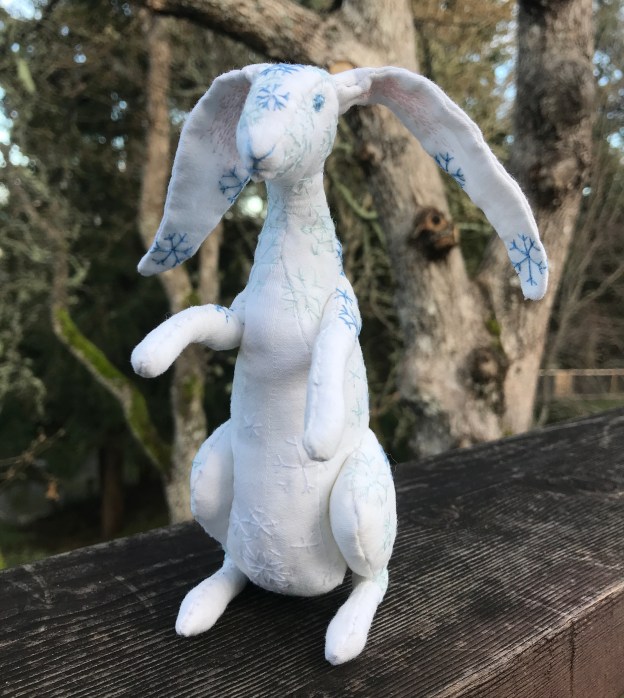I have fallen down a rabbit hole or, more accurately, am sitting in a hare’s form looking up at the stars and sewing. As someone who has believed they hate sewing and are not good at sewing for far more than half their probable lifespan I’m doing a lot of sewing. I have a theory about the reason, but first, some of the results.
Hares. The European Brown Hare is a focus for folklore (for an overview, read Terri Windling’s ‘Following the Hare‘). For 29 years we lived in one of the last areas of the UK where hares are still relatively frequent. From late February on I’d see them in the fields, always at a distance because they are so incredibly alert to danger. Females ‘boxing’ unwanted males, single adults sitting quietly in the sun. Occasionally the mangled bloody remains left by illegal hare-coursers who set sight-hounds (lurchers and greyhounds) on them and bet huge sums of money on the dog most likely to kill.
I love hares. I miss them most in late winter, when for nearly 30 years I’ve been looking forward to seeing them again. I have stitched hares and moons in handspun silk and indigo (the tattoo that completes my sleeve will be a hare-in-the-moon). My first serious attempt at tapestry last year was a tiny hare waiting in the snow for something, worked in remnants of handspun knitting and weaving yarns.

That was before I made the bears, and before I encountered the works of Mr. Finch. I had seen fabric dolls before, most painfully cute. These are not cute toys. Johanna Flanagan’s dolls (The Pale Rook) are not cute toys. How are such things made?
‘First, catch your hare’… I bought a bird pattern from Ann Wood Handmade and made a Bluebird of Happiness for a friend.

That was tricky but satisfying. I bought another Ann Wood pattern (in my defence it was on sale) and this time modified the pattern pieces slightly even before making the first Bunny.

Now I thought I knew how to do this. I drew a hare, not the best hare ever, and used that shape as the basis for pattern pieces sketched directly on freezer paper (I’d read that being thicker it is better for patterns). The bears and the bird had taught me that finer and closely-woven fabrics in not-slippery material (silk is slippery) are easiest to work with, so I used an old cotton pillowcase from my ‘Indigo THIS’ cupboard.

I am pleased. The result is not quite the shape I imagined but, having made it, I know how to change the pattern pieces to make what i see in my mind’s eye. My Winter Hare. 15cm (about 6 inches) high, entirely hand sewn, no armature. It works. I made a HARE. With an enigmatic expression.
I love it.


The tail was a nuisance. Everyone’s first thought — including mine — is a pompom or other soft fluffy thing. Total fail, or at least I thought so.
The Hare is not quite complete as it stands. Eventually it will stand on its own tiny piece of snow, a handspun handwoven tapestry, but I have to finish another tapestry to free the loom to weave that.
I had only the Winter Hare in my head when I started this. Now this is the December Hare, the first of a Calendar of Hares, each a hand-stitched tiny sculpture. I know what the January Hare will look like if I can work out how to cut the pattern pieces. And some of the others are taking shape in my head, too.
Why am I sewing? I have asked myself that question many times, sitting in my chair in the evening making tiny stitches (I wear +3.5 magnifying glasses for some of this work), unpicking those in the wrong place, trying again. I look at my book collection: the Japanese semamori stitches at the back neck of a child’s jacket lacking the line of stitches down the centre of an adult jacket needing two lengths of fabric for the width of adult shoulders, and I think of Sheila Paine’s books charting the meaning of stitch across different cultures. Amuletic stitches, each a tiny wish and hope from the maker for the well-being of the person for whom the item is made. And I know that this is why I am stitching so much: 2020 has been a very bad year. Worse, for myself and my friends in the UK it is the culmination of a series of bad years each of which has been worse and offered less hope than those before it. I feel powerless to help myself, let alone my friends. All I can do is stitch. Tiny precise stitches, each a hope and a wish for better times for those I care for. It’s a very strange and very moving experience to realise that my fingers, my mind and my heart are working together as the fingers and minds and hearts of women have worked together for as long as we’ve had needles and thread to make things for those we love.
With every stitch I wish to mend the world.

